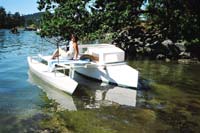|
Captain Deb okays the anchorage |
 |
|
Hello Ducksters,
It was a fun, warm summer up here on Vancouver Island and Deb and I got ALOT of use out of BIG ZEN. One of the truly great things about small boats is that you can jump in them and be “out there” in literally one or two minutes.
We are liveaboards and we pay the extra moorage rate for BZ ($30 U.S. a month) to have her right there whenever the mood strikes. And during those fab summer months, the mood usually strikes about twice a day. Now that the weather has turned, I might go out just once a week or so. It might be chilly, but it’s still heaven.
So what did we learn about BIG ZEN over the past few months? Well first of all I’m totally delighted at how well the boat handles in general. At just over 15 feet LOA, she’s not exactly long, but being a multihull she’s incredibly stable out there where it counts. I had the opportunity to take her out, past the breakwaters, during a couple of strong summer squalls. It was great fun! There was 3-4 foot, short steep waves and the wind was really blowing (30-40 kts. I would guess, with a long fetch). The boat felt very solid and steady. There were some BIG monohulls out there that were rolling sheer to sheer! I was “on deck”, sitting in my folding chair, feeling comfortable and secure.
|
A young “visitor” swims in out of the blue. Was it “Flipper Boy”? |
|
When I originally designed and built her, she was given a 6 inch (main hull) draft. Version 1.2 ( the sketch in the previous article) was going to have a 12 inch draft in order to accommodate the weight of many more batteries, to feed the electric motor.
I’m glad I stuck to the original plans ( the 6 inch rocker), because it’s going to be sweet for sailing.
The electric motor is great. It’s quiet, reliable, etc., but there are alot of drawbacks. To get some serious range and to be able to recharge “off the grid” ends up being REALLY expensive. I’m talking thousands here. Besides batteries, you’ll need cutting edge chargers, solar panels, all kinds of meters, etc., etc..
|
Lots of room in this micro-cruiser. With two people aboard and all stocked up for a vaca, the bow will just kiss the water. |
 |
|
When we were floating around this summer, I discovered that I really did miss hoisting up something…anything! There was almost always a gentle to good breeze blowing and it felt foolish not to make use of Mother Natures freebies.
So this coming spring I’m going to implement the following :
The rigging will be very simple. So far, the idea is to make a 3-4 foot pole out of fir and fix it to the deck. The carbon windsurfer mast will simply sleeve over it and will be able to rotate 360 if needed. That should leave me with a total of um…one line only! Gets blowy? Let the line gowy!!
|
Another beautiful North-West alcove… all to ourselves.
The electric motor is clearly seen here. That’s a good place for it, by the way. No problems with cavitation and good enough steering response.
|
|
I’m often asked about that flat-bottomed main hull. It works just fine, thank you very much. I’ve always been a fan of flat-bottoms.
(All praise and honor goes to the undisputed Guru of Flat, Phil Bolger. I keep a little alter at home, with his photo on it. Candles are lit, inscense is burnt, Oh! Henry Bars are offered up…to this genius of home-builts). You go, Phil!
Flatties do have some limitations, but not as many as most people think. It’s only when you’re driving hard, directly into short, steep seas that they begin to pound. And that is really just a matter of noise. If the hull is built strongly enough on the bottom, no problem. In those kinds of conditions, the smallest change in heading usually eliminates 90% of the beating anyway.
Down wind and even on a reach, you can’t beat flat as far as I’m concerned.
If I had wanted a longer boat though ( say 24 feet ) I would have gone with a deep V main hull. They are the absolute easiest, quickest, cheapest, lightest hulls to build. FAR easier than a “simple box”. I’ve got a few sketches happening ( oh no!!) so don’t touch that dial…
Happy Boating to All,
Claudio

